2010 TOYOTA COROLLA parking brake
[x] Cancel search: parking brakePage 2 of 476
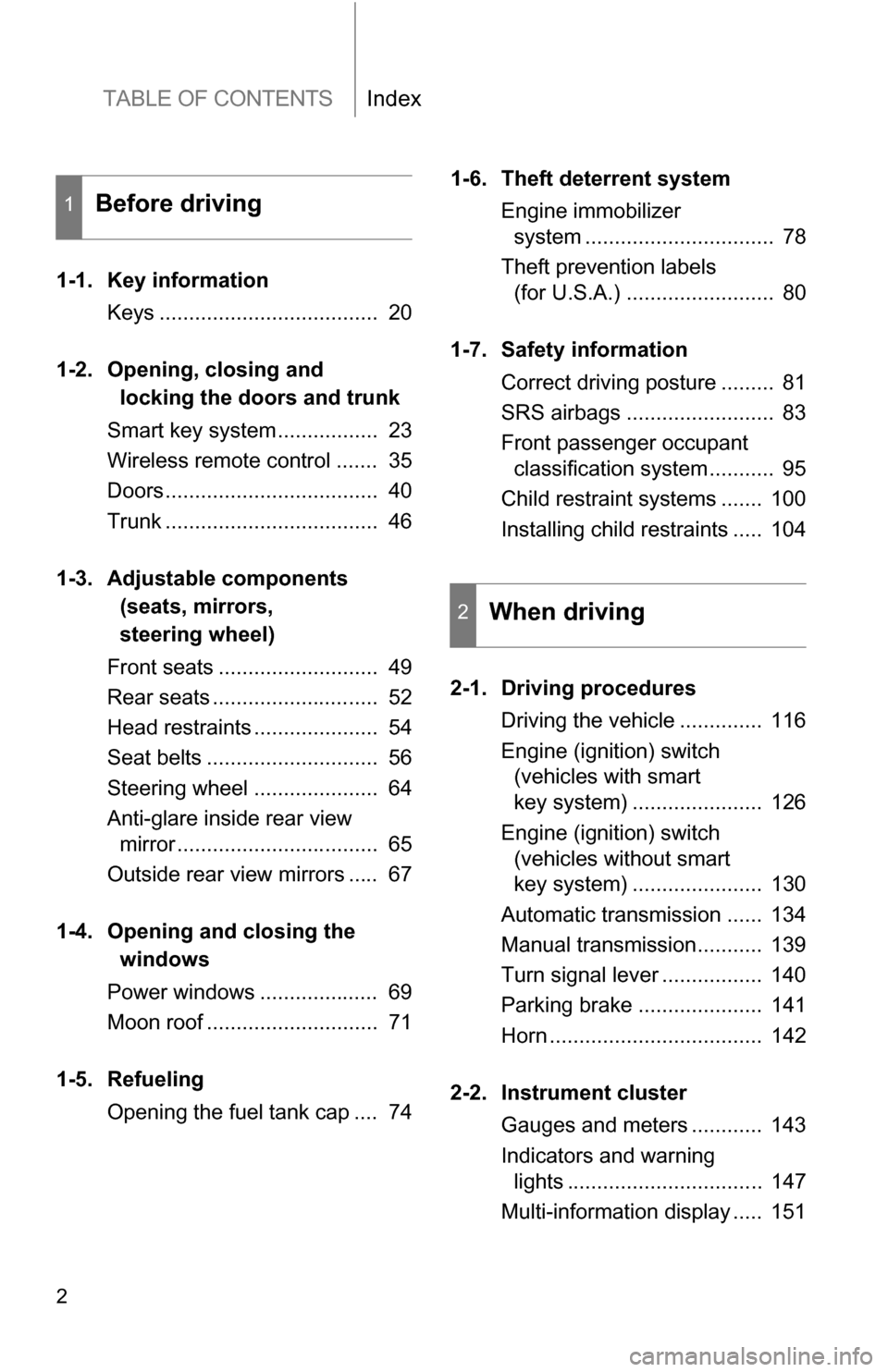
TABLE OF CONTENTSIndex
2
1-1. Key informationKeys ..................................... 20
1-2. Opening, closing and locking the doors and trunk
Smart key system................. 23
Wireless remote control ....... 35
Doors.................................... 40
Trunk .................................... 46
1-3. Adjustable components (seats, mirrors,
steering wheel)
Front seats ........................... 49
Rear seats ............................ 52
Head restraints ..................... 54
Seat belts ............................. 56
Steering wheel ..................... 64
Anti-glare inside rear view mirror .................................. 65
Outside rear view mirrors ..... 67
1-4. Opening and closing the windows
Power windows .................... 69
Moon roof ............................. 71
1-5. Refueling Opening the fuel tank cap .... 74 1-6. Theft deterrent system
Engine immobilizer system ................................ 78
Theft prevention labels (for U.S.A.) ......................... 80
1-7. Safety information Correct driving posture ......... 81
SRS airbags ......................... 83
Front passenger occupant classification system ........... 95
Child restraint systems ....... 100
Installing child restraints ..... 104
2-1. Driving procedures Driving the vehicle .............. 116
Engine (ignition) switch (vehicles with smart
key system) ...................... 126
Engine (ignition) switch (vehicles without smart
key system) ...................... 130
Automatic transmission ...... 134
Manual transmission........... 139
Turn signal lever ................. 140
Parking brake ..................... 141
Horn .................................... 142
2-2. Instrument cluster Gauges and meters ............ 143
Indicators and warning lights ................................. 147
Multi-information display ..... 151
1Before driving
2When driving
Page 8 of 476

8
Glove box P. 269
Grocery bag hook
P. 278
SRS side airbags P. 83
Power window
switches
P. 69
SRS front
passenger
airbag
P. 83
SRS driver airbag P. 83
A
Console box P. 269
InteriorPictorial index
Floor mat P. 286
Head restraints P. 54
Armrest P. 285
Seat belts P. 56
Auxiliary boxes P. 273
Parking brake lever P. 141
Shift lever P. 134, 139
Front seats P. 49
Cup holders P. 271
Cup holders P. 271
Page 115 of 476
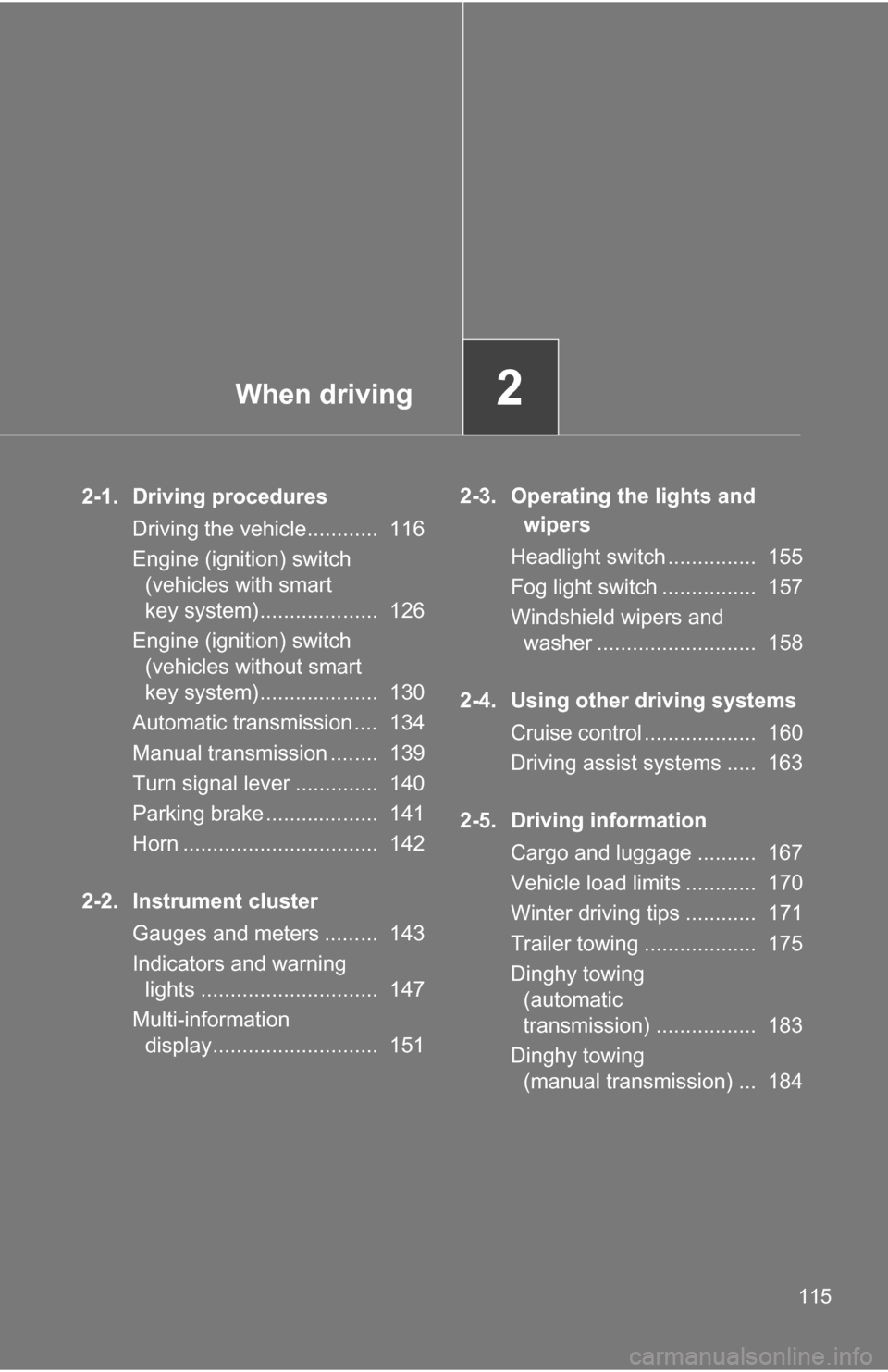
When driving2
115
2-1. Driving proceduresDriving the vehicle............ 116
Engine (ignition) switch (vehicles with smart
key system).................... 126
Engine (ignition) switch (vehicles without smart
key system).................... 130
Automatic transmission .... 134
Manual transmission ........ 139
Turn signal lever .............. 140
Parking brake ................... 141
Horn ................................. 142
2-2. Instrument cluster Gauges and meters ......... 143
Indicators and warning lights .............................. 147
Multi-information display............................ 151 2-3. Operating the lights and
wipers
Headlight switch ............... 155
Fog light switch ................ 157
Windshield wipers and washer ........................... 158
2-4. Using other driving systems Cruise control ................... 160
Driving assist systems ..... 163
2-5. Driving information Cargo and luggage .......... 167
Vehicle load limits ............ 170
Winter driving tips ............ 171
Trailer towing ................... 175
Dinghy towing (automatic
transmission) ................. 183
Dinghy towing (manual transmission) ... 184
Page 116 of 476

116
2-1. Driving procedures
Driving the vehicle
The following procedures should be observed to ensure safe driv-
ing.
■ Starting the engine
P. 126, 130
■ Driving
Automatic transmission
With the brake pedal depressed, shift the shift lever to D. ( P. 134)
Release the parking brake. ( P. 141)
Gradually release the brake pedal and gently depress the
accelerator pedal to accelerate the vehicle.
Manual transmission With the clutch pedal fully depressed, shift the shift lever to
1. ( P. 139)
Release the parking brake. ( P. 141)
Gradually release the clutch pedal. At the same time, gently
depress the accelerator pedal to accelerate the vehicle.
■ Stopping
Automatic transmission
With the shift lever in D, depress the brake pedal.
If necessary, set the parking brake.
When the vehicle is stopped for an extended period of time, shift
the shift lever to P or N. ( P. 134)
Manual transmission
With the clutch pedal fully depressed, depress the brake
pedal.
If necessary, set the parking brake.
When the vehicle is stopped for an extended period of time, shift
the shift lever to N. ( P. 139)
STEP 1
STEP 2
STEP 3
STEP 1
STEP 2
STEP 3
STEP 1
STEP 2
STEP 1
STEP 2
Page 117 of 476
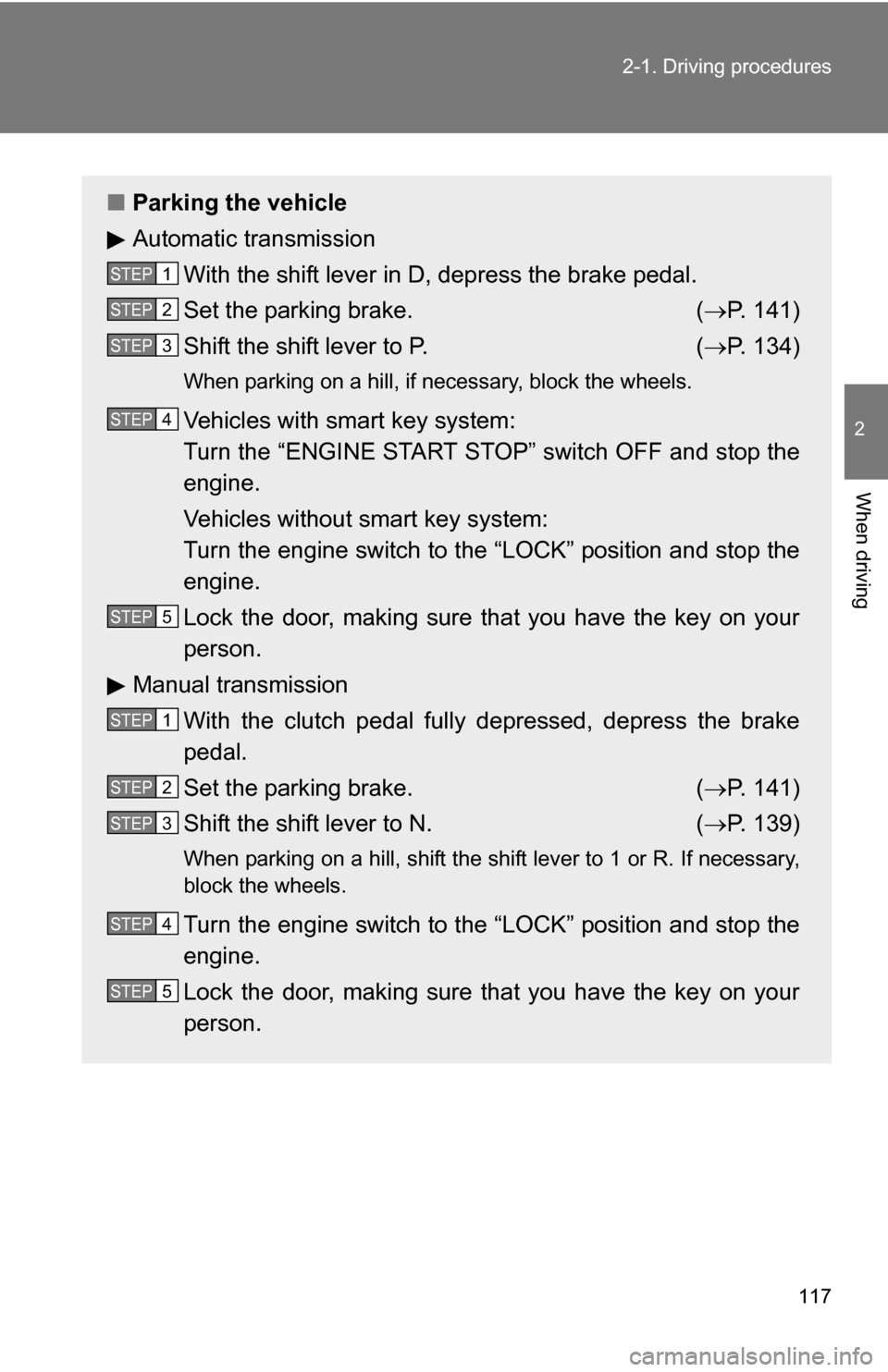
117
2-1. Driving procedures
2
When driving
■
Parking the vehicle
Automatic transmission
With the shift lever in D, depress the brake pedal.
Set the parking brake. ( P. 141)
Shift the shift lever to P. ( P. 134)
When parking on a hill, if necessary, block the wheels.
Vehicles with smart key system:
Turn the “ENGINE START STOP” switch OFF and stop the
engine.
Vehicles without smart key system:
Turn the engine switch to the “LOCK” position and stop the
engine.
Lock the door, making sure that you have the key on your
person.
Manual transmission
With the clutch pedal fully depressed, depress the brake
pedal.
Set the parking brake. ( P. 141)
Shift the shift lever to N. ( P. 139)
When parking on a hill, shift the shift lever to 1 or R. If necessary,
block the wheels.
Turn the engine switch to the “LOCK” position and stop the
engine.
Lock the door, making sure that you have the key on your
person.
STEP 1
STEP 2
STEP 3
STEP 4
STEP 5
STEP 1
STEP 2
STEP 3
STEP 4
STEP 5
Page 118 of 476
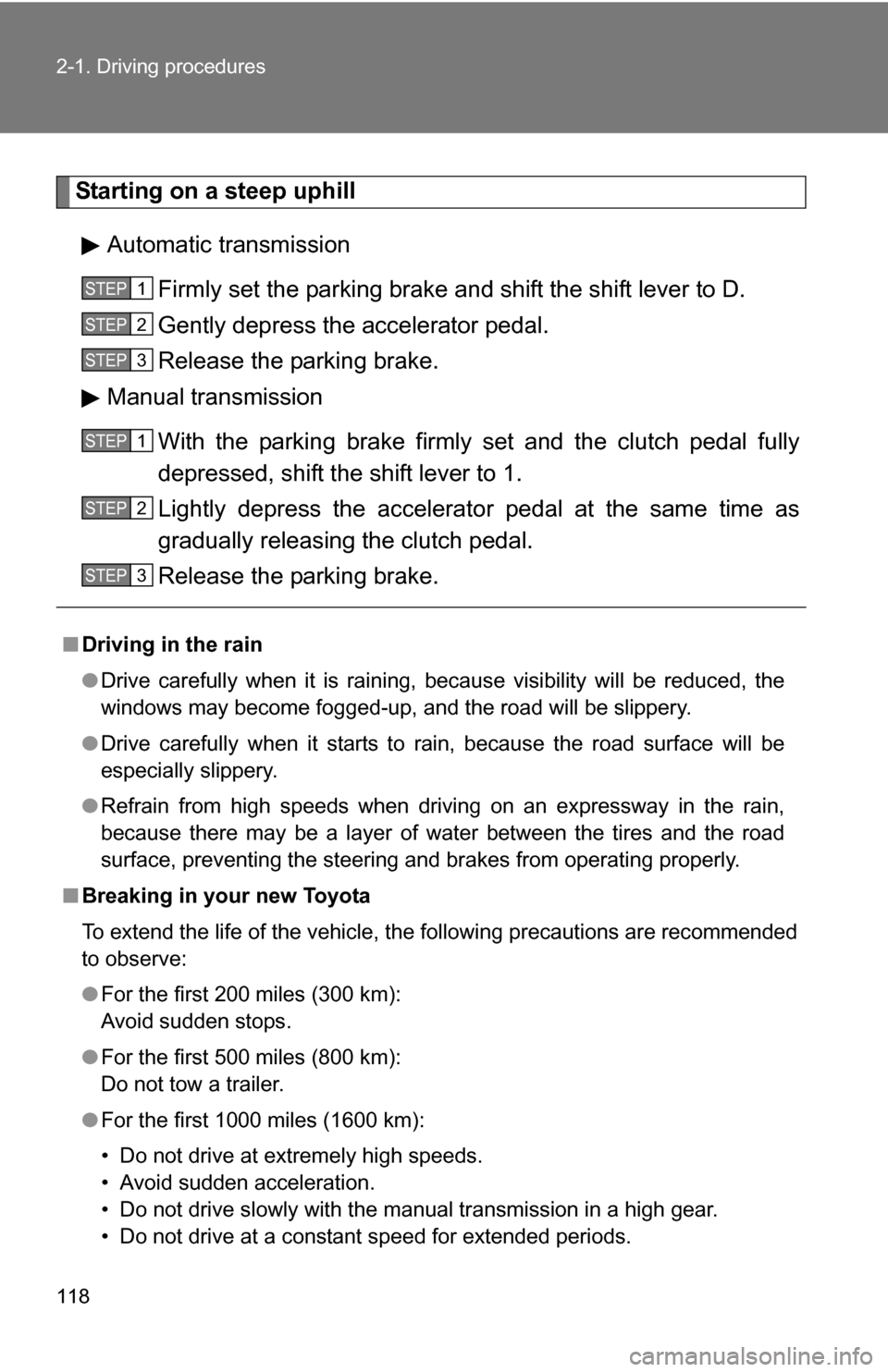
118 2-1. Driving procedures
Starting on a steep uphillAutomatic transmission Firmly set the parking brake and shift the shift lever to D.
Gently depress the accelerator pedal.
Release the parking brake.
Manual transmission
With the parking brake firmly set and the clutch pedal fully
depressed, shift the shift lever to 1.
Lightly depress the accelerator pedal at the same time as
gradually releasing the clutch pedal.
Release the parking brake.
■Driving in the rain
●Drive carefully when it is raining, because visibility will be reduced, the
windows may become fogged-up, and the road will be slippery.
● Drive carefully when it starts to rain, because the road surface will be
especially slippery.
● Refrain from high speeds when driving on an expressway in the rain,
because there may be a layer of water between the tires and the road
surface, preventing the steering and brakes from operating properly.
■ Breaking in your new Toyota
To extend the life of the vehicle, the following precautions are recommended
to observe:
●For the first 200 miles (300 km):
Avoid sudden stops.
● For the first 500 miles (800 km):
Do not tow a trailer.
● For the first 1000 miles (1600 km):
• Do not drive at extremely high speeds.
• Avoid sudden acceleration.
• Do not drive slowly with the manual transmission in a high gear.
• Do not drive at a constant speed for extended periods.
STEP 1
STEP 2
STEP 3
STEP 1
STEP 2
STEP 3
Page 120 of 476
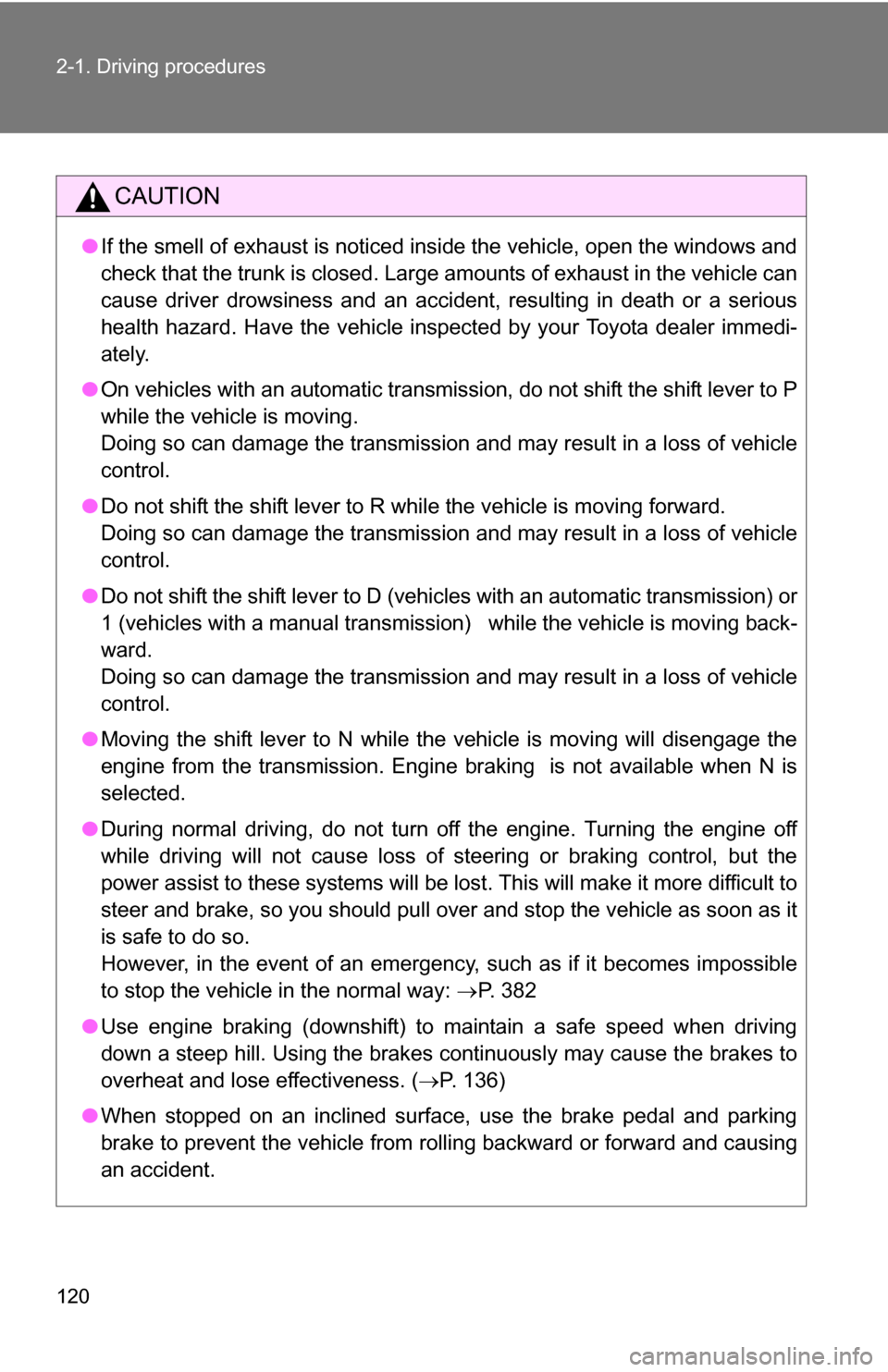
120 2-1. Driving procedures
CAUTION
●If the smell of exhaust is noticed inside the vehicle, open the windows and
check that the trunk is closed. Large amounts of exhaust in the vehicle can
cause driver drowsiness and an accident, resulting in death or a serious
health hazard. Have the vehicle inspected by your Toyota dealer immedi-
ately.
● On vehicles with an automatic transmission, do not shift the shift lever to P
while the vehicle is moving.
Doing so can damage the transmission and may result in a loss of vehicle\
control.
● Do not shift the shift lever to R while the vehicle is moving forward.
Doing so can damage the transmission and may result in a loss of vehicle\
control.
● Do not shift the shift lever to D (vehicles with an automatic transmission) or
1 (vehicles with a manual transmission) while the vehicle is moving back-
ward.
Doing so can damage the transmission and may result in a loss of vehicle\
control.
● Moving the shift lever to N while the vehicle is moving will disengage the
engine from the transmission. Engine braking is not available when N is
selected.
● During normal driving, do not turn off the engine. Turning the engine off
while driving will not cause loss of steering or braking control, but the
power assist to these systems will be lost. This will make it more difficult to
steer and brake, so you should pull over and stop the vehicle as soon as it
is safe to do so.
However, in the event of an emergency, such as if it becomes impossible
to stop the vehicle in the normal way: P. 382
● Use engine braking (downshift) to maintain a safe speed when driving
down a steep hill. Using the brakes continuously may cause the brakes to
overheat and lose effectiveness. ( P. 136)
● When stopped on an inclined surface, use the brake pedal and parking
brake to prevent the vehicle from rolling backward or forward and causing
an accident.
Page 122 of 476
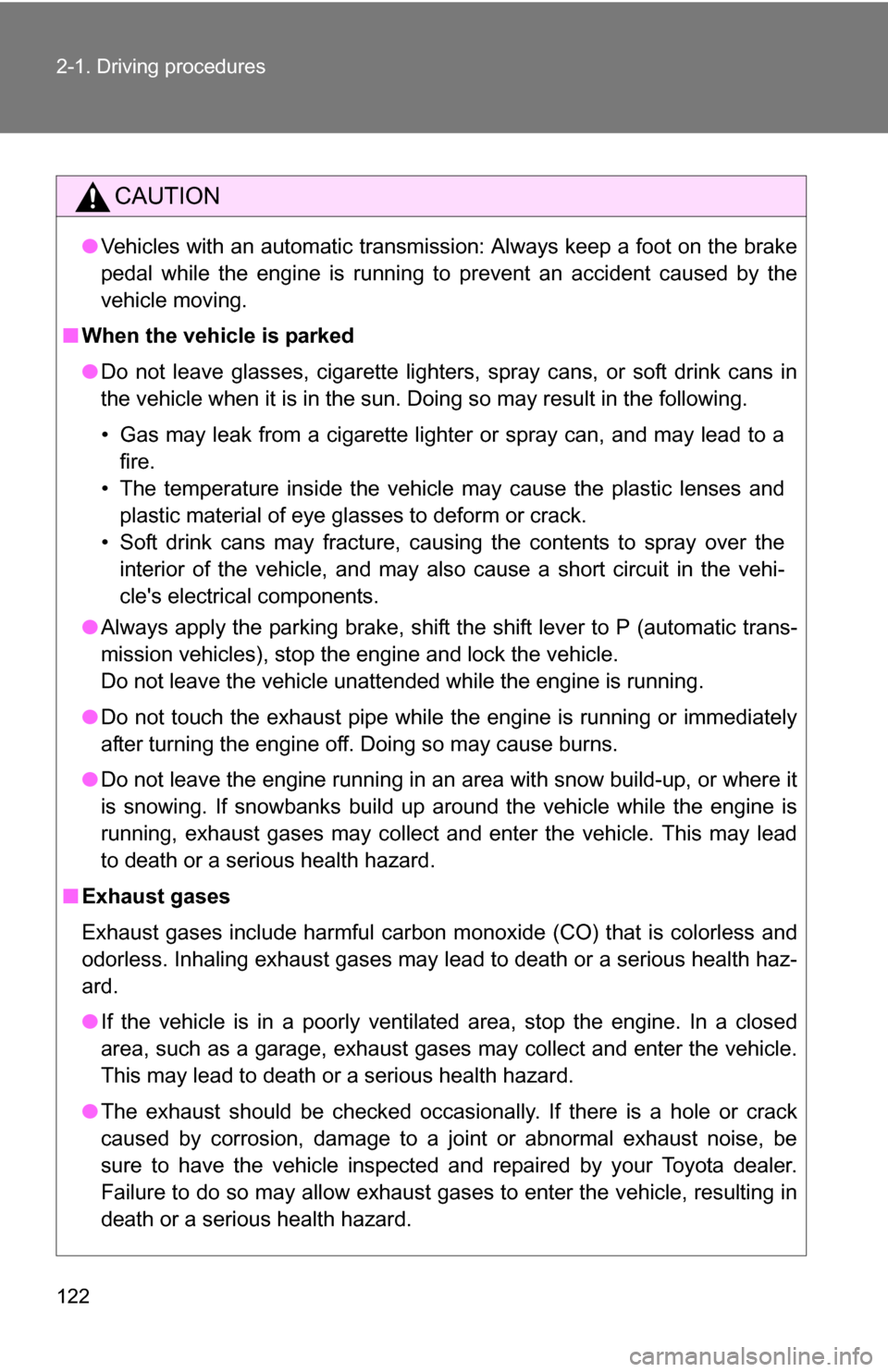
122 2-1. Driving procedures
CAUTION
●Vehicles with an automatic transmission: Always keep a foot on the brake
pedal while the engine is running to prevent an accident caused by the
vehicle moving.
■ When the vehicle is parked
●Do not leave glasses, cigarette lighters, spray cans, or soft drink cans in
the vehicle when it is in the sun. Doing so may result in the following.\
• Gas may leak from a cigarette lighter or spray can, and may lead to a
fire.
• The temperature inside the vehicle may cause the plastic lenses and plastic material of eye glasses to deform or crack.
• Soft drink cans may fracture, causing the contents to spray over the interior of the vehicle, and may also cause a short circuit in the vehi-
cle's electrical components.
● Always apply the parking brake, shift the shift lever to P (automatic trans-
mission vehicles), stop the engine and lock the vehicle.
Do not leave the vehicle unattended while the engine is running.
● Do not touch the exhaust pipe while the engine is running or immediately
after turning the engine off. Doing so may cause burns.
● Do not leave the engine running in an area with snow build-up, or where it
is snowing. If snowbanks build up around the vehicle while the engine is
running, exhaust gases may collect and enter the vehicle. This may lead
to death or a serious health hazard.
■ Exhaust gases
Exhaust gases include harmful carbon monoxide (CO) that is colorless and
odorless. Inhaling exhaust gases may lead to death or a serious health haz-
ard.
●If the vehicle is in a poorly ventilated area, stop the engine. In a closed
area, such as a garage, exhaust gases may collect and enter the vehicle.
This may lead to death or a serious health hazard.
● The exhaust should be checked occasionally. If there is a hole or crack
caused by corrosion, damage to a joint or abnormal exhaust noise, be
sure to have the vehicle inspected and repaired by your Toyota dealer.
Failure to do so may allow exhaust gases to enter the vehicle, resulting in
death or a serious health hazard.